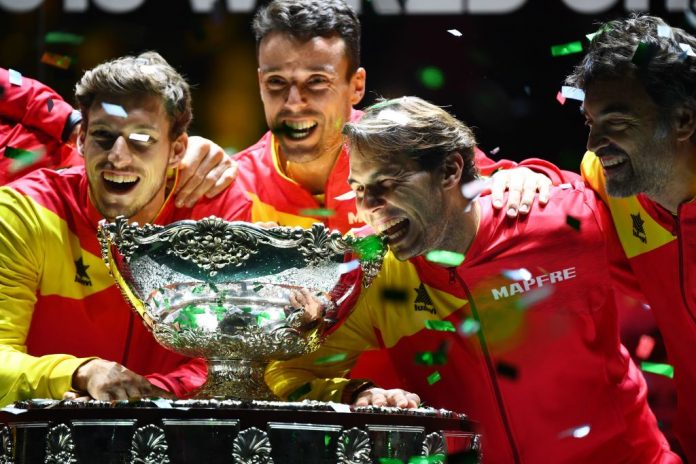The Buzz and Reflections from Spain
Bill Simons
Madrid
It’s the off season. Chilly winds cross the hemisphere and tennis is quiet.
Wrong! Just eight days ago a young Greek god, Stefanos Tsitsipas, stuck it to the supposedly dominant establishment and won the ATP Finals. This week Roger Federer has been rocking South America with exhibitions, including a record-setting Mexico City happening that drew 42,000.
All the while the Davis Cup Finals in Madrid has been quite the circus. Its soccer-happy chief likes to call it the World Cup of Tennis. A sarcastic Brit in the press room called it the World Pup of Tennis.
There were problems. Matches ended at 4:04 AM. Many of the crowds were sparse, and at times the Magic Box was virtually devoid of magic. Plus, often when there was a great match, few saw it. Was the Spain-Britain battle the greatest match that virtually no one in North America saw? Belgium’s Steve Darcis expressed a common sentiment: “It is an honor to play for my country, but please don’t call it the Davis Cup.” Boris Becker conceded that after 119 years, change was needed, but, “Tennis is, from now on, only business and politics.” Critics howled that the format was incomprehensible, and one headline read, “Foolish Reform Has Killed the Davis Cup.”
Girard Piqué, the Davis Cup financier and boss, played a big soccer match the day of the semifinal, and his wife Shakara gave a dazzling performance before the Spain vs. Canada final. He boasted that the number of Davis Cup sponsors has increased from four to eleven. But his knowledge of tennis seemed a bit spotty. He rightly noted how much Davis Cup players care, because they weep. Then he claimed, “There is no event in the year that you can see that, even in the Grand Slams. I don’t see players crying when they lose.”
Ridiculous. Just ask Roger, Rafa, Serena, Naomi and Andy Murray, who once told us that he cried better than Federer – he just wished he played better.
But, time out. If this Davis Cup thing is so bad, how come it feels so good? Yes, it was “blitz tennis,” but what a blitz. There were Croatian tubas blaring polkas, Brits singing “When the Saints Come Marching In,” rabid Argentinians and a stadium of enthralled Spaniards singing their songs in perfect harmony.
The Canadians celebrated. The Russians were tough. Americans played almost ‘til dawn, and it didn’t even matter. Rafa inspired and Novak tried. The sorrow of the defeated Serbs was a poignant commentary on the power of sports. This was an international festival of tennis far from the traditional formula, one that ultimately provided brash thrills. Despite all its thorns, its many roses gave us a modest measure of redemption.
THE BEST MATCHES NOBODY SAW: One of the obvious problems of the Davis Cup was that TV coverage of the finals in North America was scant. When it was televised it was on obscure stations. If, as organizers say, the new format was put in place to express the soul of tennis, why was coverage so meager in the most important media market in the world? Why wasn’t something done? ITF Chief Dave Haggerty told IT that the financial group Kosmos owned the TV rights and couldn’t come to an agreement with the Tennis Channel. Haggerty said conversations are already happening to get things going for next year.
NEXT YEAR IN MADRID: Serbia and France have already been given wildcards for next year’s Davis Cup final, which will again be in Madrid, during America’s Thanksgiving weekend. With the seeds allocated so early, it means that Switzerland may not be offered an olive branch wildcard to try to bring Roger Federer back into the Davis Cup fold. To get into next year’s Davis Cup finals, the US will have to beat Uzbekistan next March, the week before Indian Wells. Speaking of Indian Wells, the Davis Cup could be played there in 2021 and 2022, but it doesn’t look like a certainty.
WE’LL NEVER FORGET: The visible sorrow of the Serbian team after their third-set 10-8 defeat to Russia in the quarterfinals.
BEST FANS: 1. Argentina. 2. Croatia 3. Spain 4. Canada 5. Kazakhstan
GO FIGURE: Russian tennis Czar Shamil Tarpischev was the loudest voice for democracy at the Davis Cup. The longtime tennis chief said the new format hurts tennis development in smaller countries.
DAVIS CUP OVERACHIEVER: Canada’s No. 150 Vasek Pospisil stepped up big time.
DAVIS CUP TO-DO LIST: Change date, change scheduling of matches, improve TV coverage in North America, improve website and app, change rules on forfeits and make teams wear different colored outfits, get whacked-out energetic American cheerleaders into America’s matches to enliven them. (And here’s a tip, all you need is a non-stop drummers, some whistles and a trumpet or two.)
BEST JOURNALISTIC MOVE: During Serbia’s incredibly painful press conference after their loss to Russia, a writer asked, “Can I ask the press to clap the Serbians for their effort?” They did.
A NUMBER WE WILL REMEMBER: Tennis nerds know that the John Isner-Nicolas Mahut Wimbledon marathon took 11:05. The US finally beat Italy at 4:04 am.
A GUTSY LADY: In front of Spain’s partisans, a chair ump called Rafa for a time violation.
ROGER’S EVERYWHERE: Roger Federer is the nemisis of the new power in tennis, soccer star Gerard Pique. But even Fed was at the Davis Cup as time and again Rolex’s ads, with their proper English accents, played out on the big screen.
LISTEN UP – THERE IS ABSOLUTELY NO SUCH THING AS KARMA: Viktor Troicki, who was suspended mid-career for drug use, faltered badly in Serbia’s decisive quarterfin tiebreaker against Russia. Canadian Vasek Pospisil, who has been fighting hare for a more equitable pay system in the ATP, surged in Madrid.
ONE OF THE GREAT SIGHTS IN TENNIS: Rafa wearing his red and gold colors.
BOTTOM LINE: The Davis Cup had many problems, but it was a success.



















